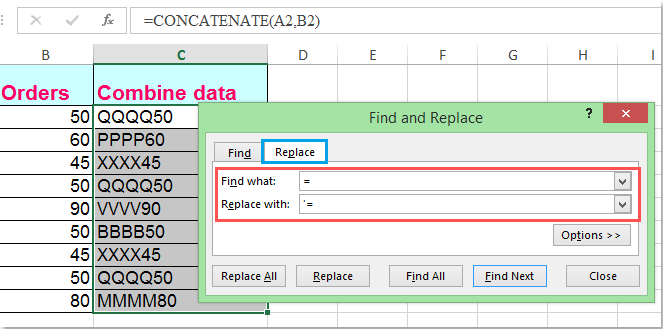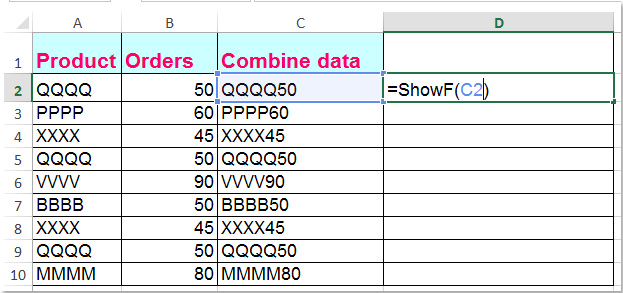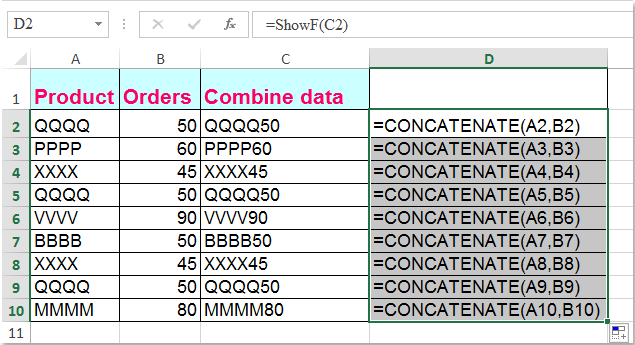Wie konvertiert man eine Formel in eine Textzeichenfolge in Excel?
Normalerweise zeigt Microsoft Excel die berechneten Ergebnisse an, wenn Sie Formeln in Zellen eingeben. Manchmal möchten Sie jedoch möglicherweise nur die Formel in der Zelle anzeigen, wie z.B. =VERKETTEN("000", " - 2"). Wie gehen Sie damit um? Es gibt mehrere Möglichkeiten, dieses Problem zu lösen:
Formel mit der Funktion 'Suchen und Ersetzen' in eine Textzeichenfolge umwandeln
Formel mit einem einzigen Klick in eine Textzeichenfolge oder umgekehrt umwandeln
Formel mit einer benutzerdefinierten Funktion in eine Textzeichenfolge umwandeln
Formel mit der Funktion 'Suchen und Ersetzen' in eine Textzeichenfolge umwandeln
Angenommen, Sie haben einen Bereich von Formeln in Spalte C, und Sie müssen die Spalte mit den ursprünglichen Formeln anzeigen, aber nicht deren berechnete Ergebnisse, wie in den folgenden Screenshots gezeigt:
 |  |
Um diese Aufgabe zu lösen, kann Ihnen die Funktion ' Suchen und Ersetzen' helfen. Gehen Sie bitte wie folgt vor:
1. Wählen Sie die Zellen mit den berechneten Ergebnissen aus, die Sie in eine Textzeichenfolge umwandeln möchten.
2. Drücken Sie dann gleichzeitig die Tasten Strg + H, um das Dialogfeld 'Suchen und Ersetzen' zu öffnen. Im Dialogfeld, unter dem Reiter 'Ersetzen', geben Sie das Gleichheitszeichen = in das Feld 'Suchen nach' ein und '= in das Feld 'Ersetzen durch'. Siehe Screenshot:

3. Klicken Sie dann auf die Schaltfläche 'Alle ersetzen'. Sie sehen, dass alle berechneten Ergebnisse durch die ursprünglichen Formeltexte ersetzt wurden. Siehe Screenshot:

Formel mit einem einzigen Klick in eine Textzeichenfolge oder umgekehrt umwandeln
Wenn Sie Kutools für Excel haben, können Sie mit der Funktion 'Formeln in Text umwandeln' mehrere Formeln mit nur einem Klick in Textzeichenfolgen umwandeln.
Nach der Installation von Kutools für Excel gehen Sie bitte wie folgt vor:
1. Wählen Sie die Formeln aus, die Sie umwandeln möchten.
2. Klicken Sie auf Kutools > Text > Formeln in Text umwandeln, und Ihre ausgewählten Formeln werden sofort in Textzeichenfolgen umgewandelt. Siehe Screenshot:

Tipp: Wenn Sie die Formeltexte wieder in die berechneten Ergebnisse umwandeln möchten, wenden Sie einfach das Hilfsmittel 'Text in Formel umwandeln' an, wie im folgenden Screenshot gezeigt:

Jetzt Kutools für Excel herunterladen und kostenlos testen!
Formel mit einer benutzerdefinierten Funktion in eine Textzeichenfolge umwandeln
Der folgende VBA-Code kann Ihnen auch dabei helfen, dies problemlos zu bewältigen.
1. Halten Sie in Excel die Tasten Alt + F11 gedrückt, um das Fenster 'Microsoft Visual Basic for Applications' zu öffnen.
2. Klicken Sie auf Einfügen > Modul, und fügen Sie das folgende Makro im Modulfenster ein.
Function ShowF(Rng As Range)
ShowF = Rng.Formula
End Function
3. Geben Sie in einer leeren Zelle, wie Zelle D2, die Formel =ShowF(C2) ein.

4. Klicken Sie dann auf Zelle D2 und ziehen Sie den Ausfüllkursor ![]() in den gewünschten Bereich.
in den gewünschten Bereich.

Die besten Produktivitätstools für das Büro
Stärken Sie Ihre Excel-Fähigkeiten mit Kutools für Excel und genießen Sie Effizienz wie nie zuvor. Kutools für Excel bietet mehr als300 erweiterte Funktionen, um die Produktivität zu steigern und Zeit zu sparen. Klicken Sie hier, um die Funktion zu erhalten, die Sie am meisten benötigen...
Office Tab bringt die Tab-Oberfläche in Office und macht Ihre Arbeit wesentlich einfacher
- Aktivieren Sie die Tabulator-Bearbeitung und das Lesen in Word, Excel, PowerPoint, Publisher, Access, Visio und Project.
- Öffnen und erstellen Sie mehrere Dokumente in neuen Tabs innerhalb desselben Fensters, statt in neuen Einzelfenstern.
- Steigert Ihre Produktivität um50 % und reduziert hunderte Mausklicks täglich!
Alle Kutools-Add-Ins. Ein Installationspaket
Das Kutools for Office-Paket bündelt Add-Ins für Excel, Word, Outlook & PowerPoint sowie Office Tab Pro und ist ideal für Teams, die mit mehreren Office-Anwendungen arbeiten.
- All-in-One-Paket — Add-Ins für Excel, Word, Outlook & PowerPoint + Office Tab Pro
- Ein Installationspaket, eine Lizenz — in wenigen Minuten einsatzbereit (MSI-kompatibel)
- Besser gemeinsam — optimierte Produktivität in allen Office-Anwendungen
- 30 Tage kostenlos testen — keine Registrierung, keine Kreditkarte erforderlich
- Bestes Preis-Leistungs-Verhältnis — günstiger als Einzelkauf der Add-Ins